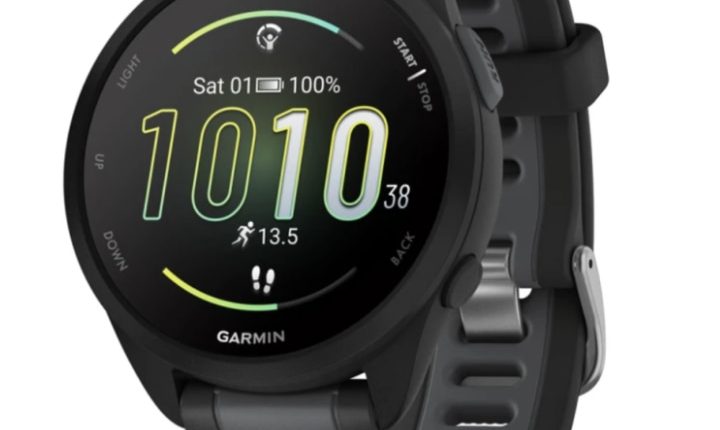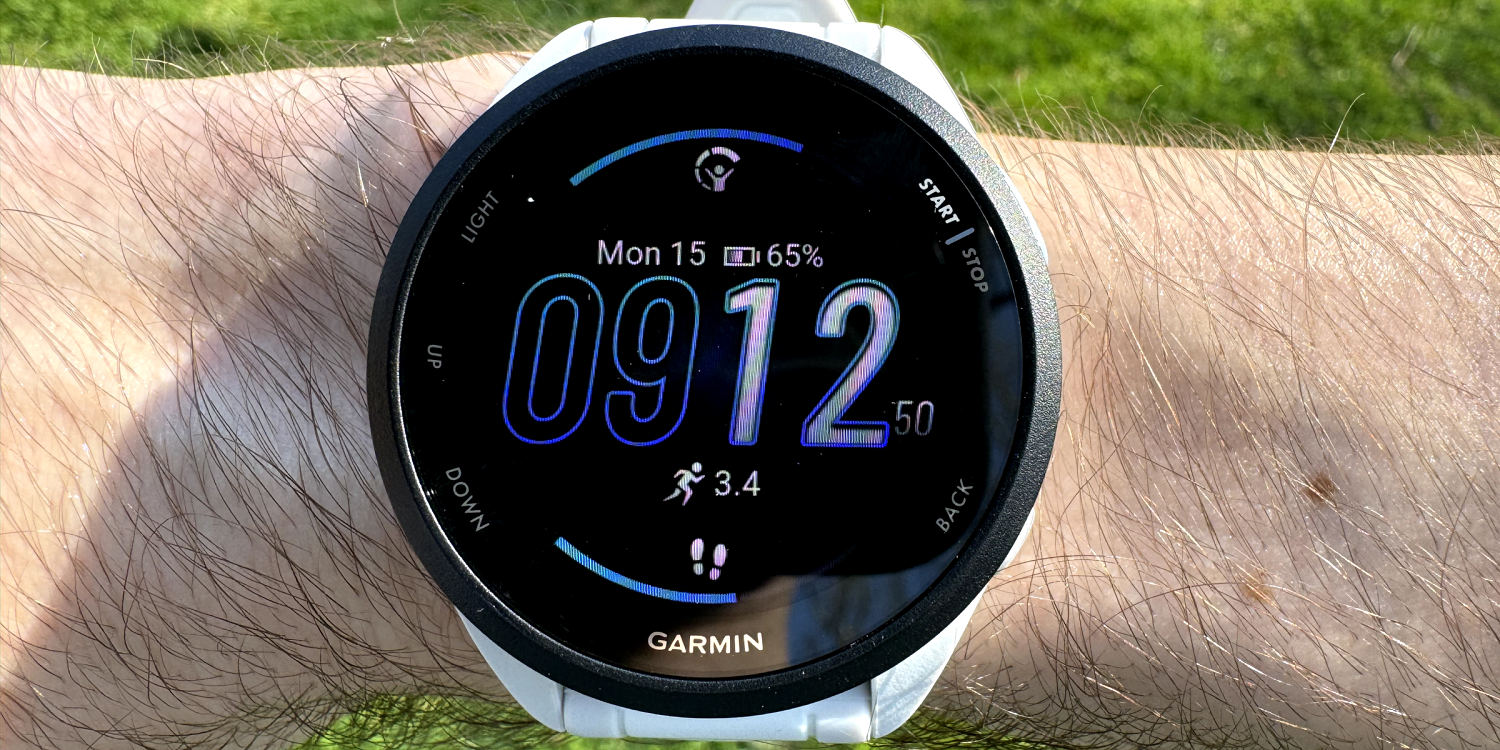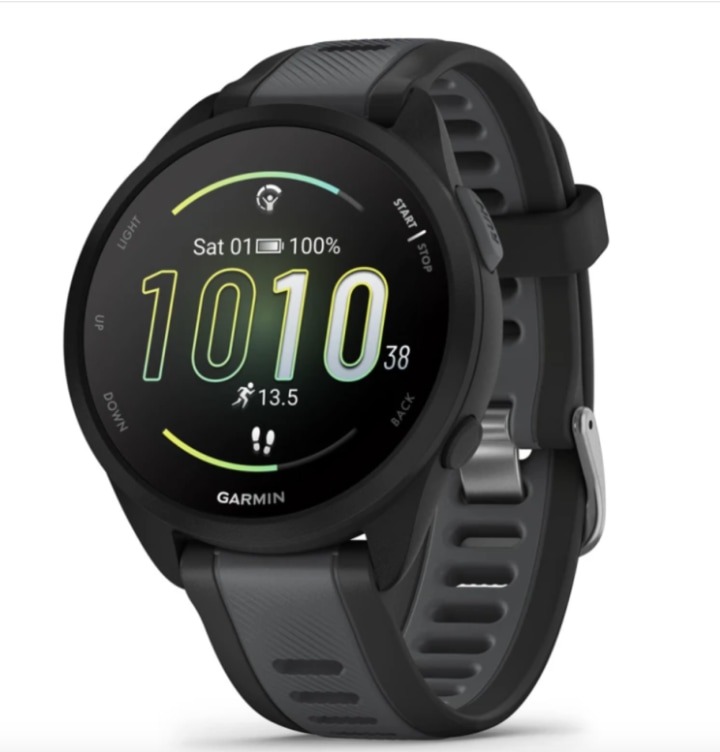Garmin makes some of the best fitness trackers and smartwatches for runners and athletes, but it is not typically a brand I recommend to people outside that crowd. Its watches have, historically, been expensive, complicated or dated compared to other options, in my experience.
The Garmin Forerunner 165 is none of these things — it is a robust smartwatch with many of the brand’s best features for $250. I tried it for over a month (after the brand sent me a sample to try out), and I am now seriously considering buying it as my new fitness tracker of choice. As a tech reporter who tries new wearables monthly, that’s saying a lot.
SKIP AHEAD What is the Garmin Forerunner 165? | How I tried the Garmin Forerunner 165 | Our experience with the Garmin Forerunner 165 | Who is the Garmin Forerunner 165 for?
What is the Garmin Forerunner 165?
Garmin Forerunner 165
The Garmin Forerunner 165 ($249.99) is a fitness watch that tracks a plethora of metrics, including heart rate, daily steps, calories burned, floors climbed, detailed running data, sleep, stress, blood oxygen and menstrual cycle. Like most smartwatches, it syncs with your phone to show text, call and email notifications. It also has many training tools built into the watch like Garmin Coach, Training Plans, and Daily Suggested Workouts (more on these below).
This watch, which comes in black and white, has a colorful touch screen and five buttons around the edges: you can use either (or both) to control the watch. It’s only available in one size and requires a Garmin account to use.
It is priced as an entry-level option in Garmin’s Forerunner lineup compared to the similarly-new Forerunner 265 ($499) and Forerunner 965 ($599).
Display: 43mm touchscreen | Weight: 39g | Battery life: Up to 11 days | Built-in GPS: Yes | Sleep tracking: Yes (including naps) | Heart-rate monitor: Yes, no EKG | Water resistance: Yes, up to 50 meters | Works best with: Garmin app (iPhone or Android)
How I tried the Garmin Forerunner 165
I’ve been testing the Garmin Forerunner 165 for over a month alongside NBC Select editorial director Lauren Swanson — the brand sent us two watches for review.
Since then, I have been wearing the Forerunner 165 constantly, only taking it off when it needed a charge (which was not often). I wore it for all of my indoor and outdoor fitness activities, largely running, cycling and strength training. For the first two weeks, I compared outdoor walking and running data from the Forerunner 165 to the Fitbit Charge 6, Apple Watch SE and Apple Watch Ultra 2. (I wore the Forerunner 165 on my right wrist and a competitor on my left, swapping the left option every week to compare results.)
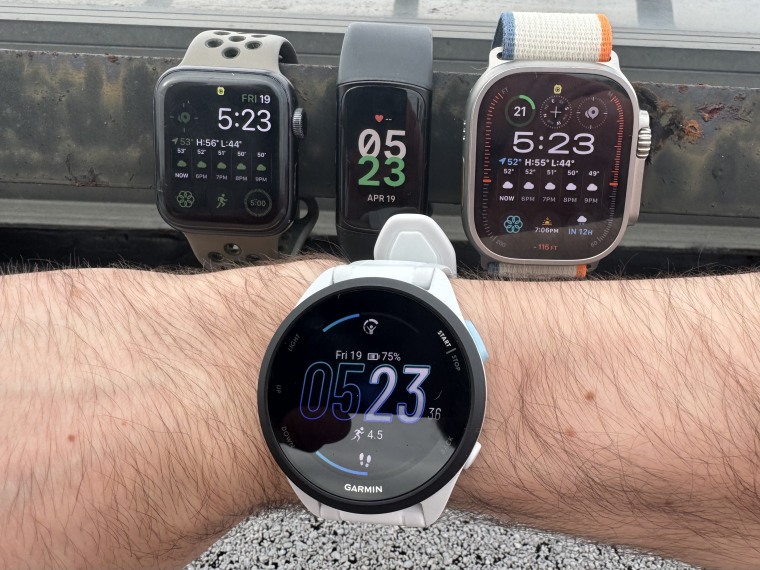
Similarly, Swanson used the Forerunner 165 to track her outdoor runs. As someone training for multiple marathons this year, she focused on the data and coaching features of the 165.
My experience with the Garmin Forerunner 165
The Forerunner 165 is one of the best fitness trackers we’ve tried, especially for runners looking to hit a personal record or sign up for a running event. It is exceedingly comfortable, has terrific battery life and is an excellent value for the features it has — I was surprised and pleased that none of it required a monthly subscription. Below, I outline in further detail my experience using the Forerunner 165.
What we like
Comfortable fit
The Forerunner 165 is the most comfortable wearable I’ve used in 2024 (yes, including the Oura Ring ($299)). I wore it continuously for about three weeks straight — it did not irritate my skin, catch on my clothes or disrupt my sleep. I never felt like taking it off, though it does look a bit sporty and out of place in some work settings (especially the white model).
The silicone band is soft, pliable and flexible, more so than silicone bands on the Apple Watch SE ($249) and Fitbit Charge 6 ($159), in my experience. The sensor on the rear of the watch is also very flat, much flatter than the round sensors on smartwatches like the Google Pixel Watch 2 ($349), which I sometimes find uncomfortable.
Though it only comes in one size, it fits both mine and Swanson’s wrists well, with a sturdy buckle and plenty of holes to adjust the fit.
Useful, customizable metrics
Garmin has a reputation for detailed fitness metrics, which is on full-display in this watch and on the Garmin Connect app. You can view most health and exercise metrics on the watch itself (though I prefer doing this on the app), including things like your recovery time, past exercises, sleep score and more.
During a run, by default, the watch displays your total time, distance, pace and heart rate gauge in bold, easy to read text. The heart rate gauge in particular is easy to read, set up like a speedometer, with higher intensity zones marked in increasing shades of red.
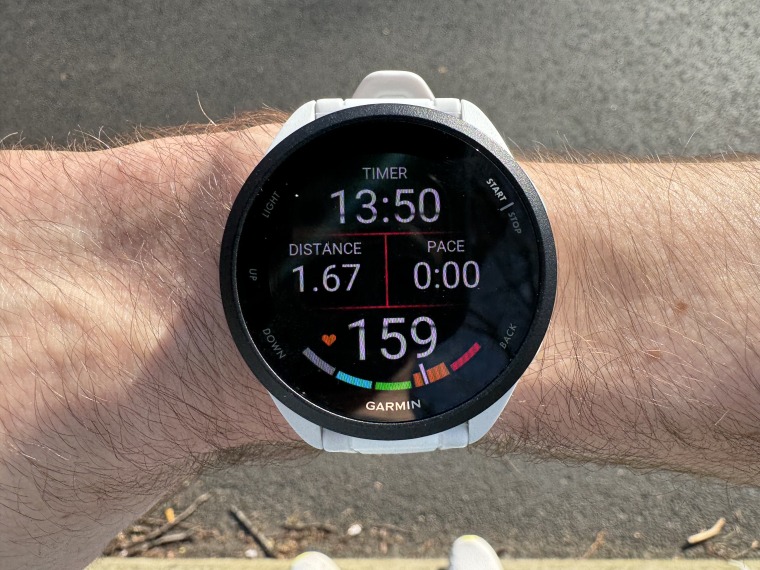
Data on the Garmin Connect app is encyclopedic (and labyrinthian at first, more on that later). It accurately tracks all my major stats (distances, heart rate, pace, time, cadence, etc.), and displays them in list and chart format. Next to nearly every data point is a help button that, when pressed, gives you a detailed explanation of the term (vertical oscillation, for example) and its impact on your run. I found this feature very helpful, especially for Garmin-specific metrics like Training Effect.

Almost everything is customizable: You can create your own watch layouts for each and every fitness activity, customize the mobile app home screen, even change the color of the exercise icons on the watch. For a tech-person like me, all these settings are fun, but I can see them being overwhelming for others.
Robust training features
We loved using training features like suggested workouts, recovery time, and Training Effect.
But the one training tool we liked most was Garmin Coach, which seems especially helpful for people who have never had a personal trainer or completed a race, says Swanson. You pick a running goal (5K, 10K, or half-marathon), your weekly running days, a race day and a virtual coach. After an initial benchmark run, Garmin will create a schedule of suggested workouts based on your goal, with easy runs, long runs, tempo runs and more. Swanson often had to skip days or rearrange her suggested runs for the week: the plan automatically adjusted her calendar every step of the way.
The watch guides you through suggested workouts in real time. It shows a timer during a warm-up section, buzzes at you if you are running too far above or below pace and more, depending on the run. As someone who has a tendency to speed up during recovery runs, this real-time feedback is invaluable.
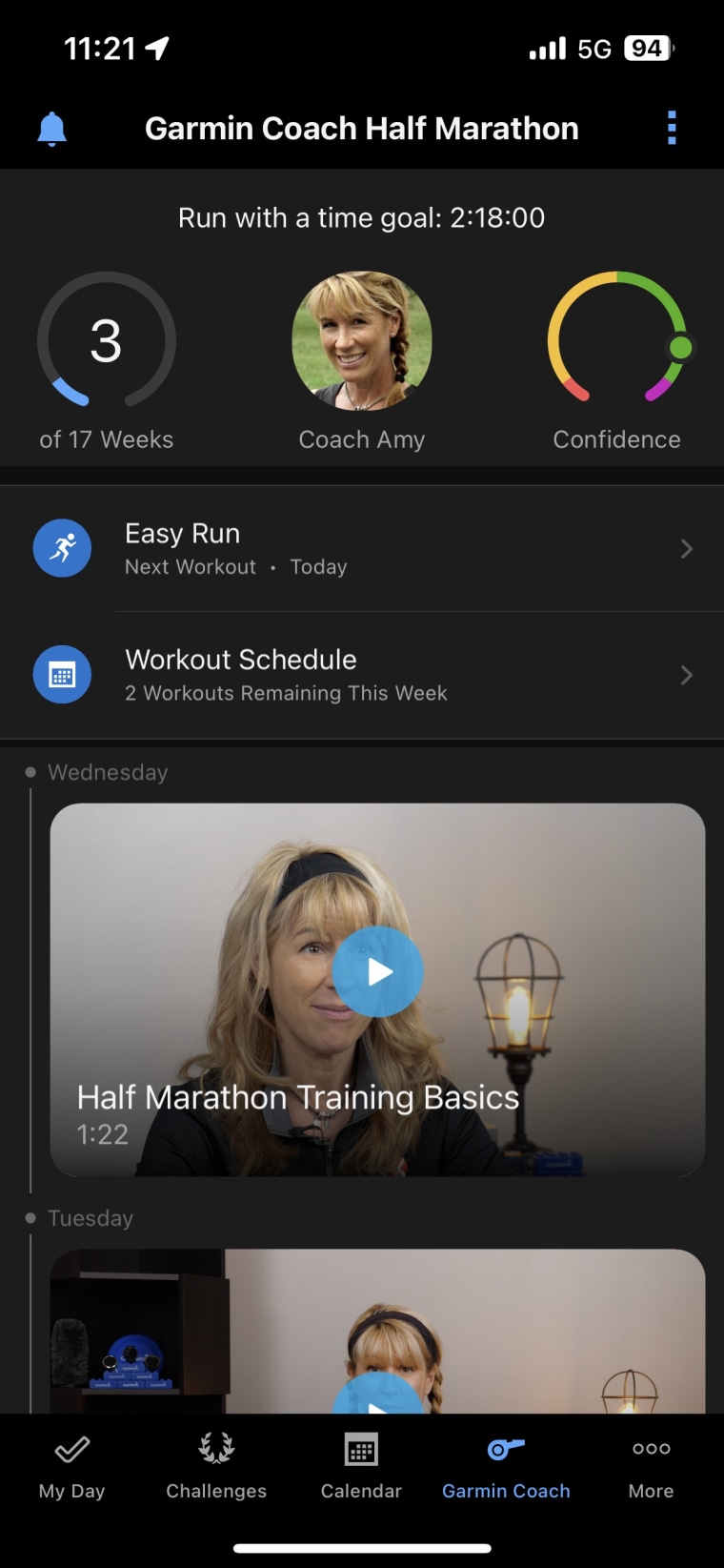
Excellent battery life
Swanson and I both consistently averaged 10 to 11 days of battery life before needing to recharge. That is far longer than every wearable from Apple, Google, Samsung and Fitbit. With the always-on display turned on, I averaged about five days on a single charge.
Charging is also relatively painless. Garmin includes a short, proprietary charging cable in the box. It plugs into the back of the watch and stays locked in — I never accidentally unplugged it, like some, more finicky charging pucks and pins.
Something magical happens when you wear a smartwatch that can go over a week without needing a charge: you forget about it. I remembered the Forerunner 165 when I needed it, and forgot about it when I didn’t. Smartwatches that I need to charge every day, by comparison, feel like a chore.
Drawbacks to keep in mind
Learning curve
The Garmin Connect and ConnectIQ apps aren’t the most intuitive to use. Both took me a few hours of use to fully understand, and I still occasionally find new settings and options, even after a month of use. Each screen has a ton of data and options to choose from, with sub-menus on sub-menus the more you tap. This is useful once you understand everything on offer, but is the opposite of something like the Fitbit app, which is more holistic and beginner-friendly.
There were also a few key features that seemed missing at first, but were there all along, just less intuitive than I would like. Two major ones were:
- Full marathon training plans: They’re available by logging in to the Garmin Connect website, not the mobile app.
- Notification customization: You can easily find this within the Garmin Connect app on Android, but not iPhone. Follow Garmin’s iOS video tutorial here for iPhone customization options.
Runners get the most features
I am a runner and a cyclist, and it’s clear that the training features are a little more fully-realized for runners. (It’s called the Forerunner, after all.) The Garmin Coach, mentioned earlier, does not have virtual coaches for cycling (only running). Similarly, cycling training plans do not suggest nearby events to sign up for, you have to input your event manually. The brand also requires additional equipment like a power meter or heart-rate monitor for accurate cycling data and training suggestions.
Who is the Garmin Forerunner 165 best for?
The Forerunner 165 watch is ideal for people who exercise regularly and want to hit a new running goal or sign up for their very first race. It has robust health and fitness stats, plus useful training tools that are a great fit for anyone who wants a little guidance, but not an actual running coach. Even without its training features, it is a fantastic fitness tracker, with superior comfort and battery life compared to other options I’ve tried.
Why trust NBC Select?
Harry Rabinowitz is a reporter at NBC Select who covers technology and fitness including guides to fitness trackers, running shoes and workout earbuds.
Lauren Swanson is the editorial director of NBC Select and an avid runner with many 5K, 10K, half-marathon and marathon finishes.
Rabinowitz and Swanson tried the Garmin Forerunner 165 for over a month after the brand sent them each a model to try out. Rabinowitz tracked his exercise, sleep and everyday metrics, and compared them to other wearables at a similar price point.
Catch up on Select’s in-depth coverage of personal finance, tech and tools, wellness and more, and follow us on Facebook, Instagram, Twitter and TikTok to stay up to date.
Source: | This article originally belongs to Nbcnews.com
